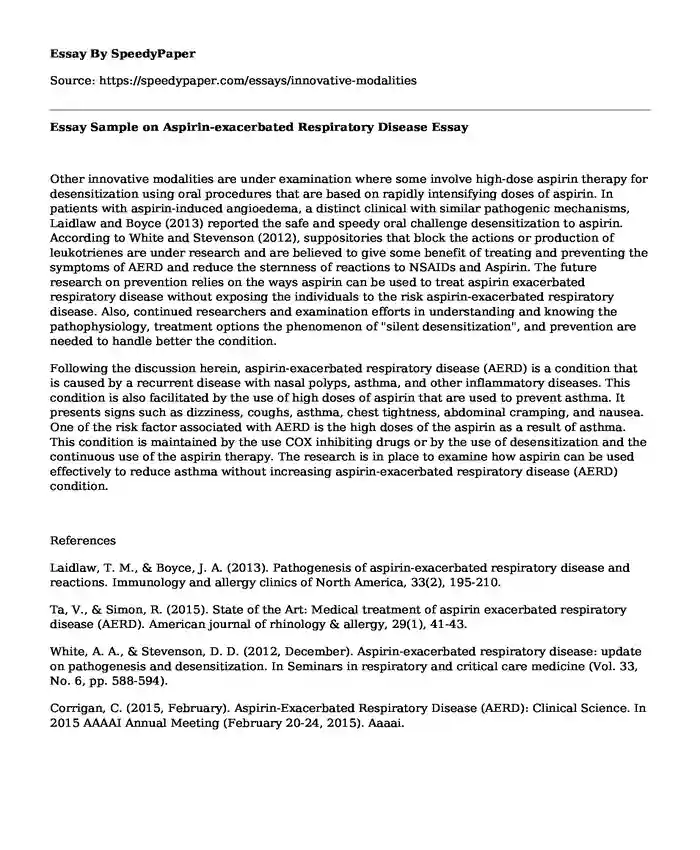
| Type of paper: | Essay |
| Categories: | Medicine Healthcare |
| Pages: | 2 |
| Wordcount: | 368 words |
Other innovative modalities are under examination where some involve high-dose aspirin therapy for desensitization using oral procedures that are based on rapidly intensifying doses of aspirin. In patients with aspirin-induced angioedema, a distinct clinical with similar pathogenic mechanisms, Laidlaw and Boyce (2013) reported the safe and speedy oral challenge desensitization to aspirin. According to White and Stevenson (2012), suppositories that block the actions or production of leukotrienes are under research and are believed to give some benefit of treating and preventing the symptoms of AERD and reduce the sternness of reactions to NSAIDs and Aspirin. The future research on prevention relies on the ways aspirin can be used to treat aspirin exacerbated respiratory disease without exposing the individuals to the risk aspirin-exacerbated respiratory disease. Also, continued researchers and examination efforts in understanding and knowing the pathophysiology, treatment options the phenomenon of "silent desensitization", and prevention are needed to handle better the condition.
Following the discussion herein, aspirin-exacerbated respiratory disease (AERD) is a condition that is caused by a recurrent disease with nasal polyps, asthma, and other inflammatory diseases. This condition is also facilitated by the use of high doses of aspirin that are used to prevent asthma. It presents signs such as dizziness, coughs, asthma, chest tightness, abdominal cramping, and nausea. One of the risk factor associated with AERD is the high doses of the aspirin as a result of asthma. This condition is maintained by the use COX inhibiting drugs or by the use of desensitization and the continuous use of the aspirin therapy. The research is in place to examine how aspirin can be used effectively to reduce asthma without increasing aspirin-exacerbated respiratory disease (AERD) condition.
References
Laidlaw, T. M., & Boyce, J. A. (2013). Pathogenesis of aspirin-exacerbated respiratory disease and reactions. Immunology and allergy clinics of North America, 33(2), 195-210.
Ta, V., & Simon, R. (2015). State of the Art: Medical treatment of aspirin exacerbated respiratory disease (AERD). American journal of rhinology & allergy, 29(1), 41-43.
White, A. A., & Stevenson, D. D. (2012, December). Aspirin-exacerbated respiratory disease: update on pathogenesis and desensitization. In Seminars in respiratory and critical care medicine (Vol. 33, No. 6, pp. 588-594).
Corrigan, C. (2015, February). Aspirin-Exacerbated Respiratory Disease (AERD): Clinical Science. In 2015 AAAAI Annual Meeting (February 20-24, 2015). Aaaai.
Cite this page
Essay Sample on Aspirin-exacerbated Respiratory Disease. (2019, May 17). Retrieved from https://speedypaper.com/essays/innovative-modalities
Request Removal
If you are the original author of this essay and no longer wish to have it published on the SpeedyPaper website, please click below to request its removal:
- Persuasive Research Paper Example on Racial Profiling
- Reflection on Race, Essay Example
- HRM Essay Sampe on the Change in the American Telephone and Telegraph Organization
- Healthcare Simulation Essay Sample
- Aristotle's Four Causes Essay Sample
- Paper Example. Role of the Central Bank
- Exploring Hydroxychloroquine: Uses, Controversies, and Ethical Concerns in the COVID-19 Era - Free Essay
Popular categories




